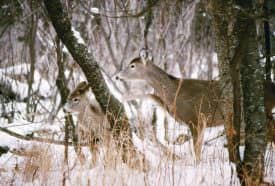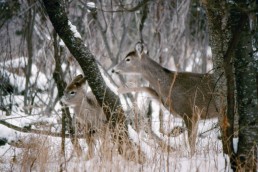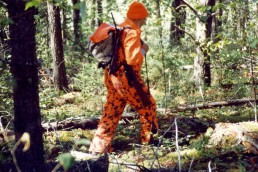Little-known Facts Every Whitetail Hunter Should Know part 2
SHARE THIS POST
After returning from their wintering areas to the relatively small home ranges of their mothers in early spring, white-tailed bucks, now 2 years old, begin to search for their first personal, buck-sized home ranges up to a one half square-mile (about 300 acres) in size. They typically find it necessary to scout great distances from their birthplaces before finding ranges with suitable size, cover, food and water not totally inhabited by one or more bucks (buck ranges overlap) of equal or greater age (Nature’s way of preventing inbreeding among whitetails).
During their first two years of life as fawns and yearlings, these young bucks were members of small herds of deer made up of protective, much-experienced mothers, one or more fawns and one or more yearlings. On becoming 2-year-olds, their lives change dramatically. Like older bucks, they become loners throughout the antler-growing season, May through August.
To avoid being discovered and pursued by dangerous predators during this period—likely to result in damage to their very sensitive, growing antlers—mature forest region bucks typically bed and feed in secluded, 1- to 2-acre areas near water, away from well-used deer trails, only occasionally exploring close portions of their ranges. For the first time in their lives they are learning to be self-sufficient, developing their all-important ability to identify predators or humans from safe distances. This gives them plenty of time to decide what to do in each case: flee with great speed, stalk silently away or remain hidden where they are. The last two options become characteristics, as they grow older.

Like 2-year-old bucks living in intensely farmed regions, they soon learn to recognize differences between non-hunting predators or humans (driving tractors, for example), which are harmless, and hunting predators or humans (sneaking on foot, often halting to listen and peer about), which are dangerous. The ability to decide what is almost always best to do under various potentially dangerous circumstances is what separates bucks from 4 1/2 to 6 1/2 years of age from all other whitetails. Their ability to avoid discovery by hunters and its consequences often reflects unusual courage through experience during hunting seasons, an infallible memory and remarkable cunning. Average hunters rarely recognize this because they so seldom see these deer. Though older does (14 1/2 years in the wild) could probably be as elusive as older bucks, they are handicapped by an instinctive determination to keep their fawns and yearlings safe.
Almost everything young whitetails must learn to be eventually able to survive on their own must be learned, first taught by their demanding mothers giving them swift kicks when they error, and then taught by example by other experienced deer, also providing swift kicks when appropriate. Whitetail can be very unkind to young deer, but lessons learned this way are quickly learned.
Many fawns born where I hunt and study whitetail do not learn what they must know to survive on their own soon enough. Between mid-May and early November, three of four newborns fall victim to gray wolves in this area. For up to a month after they are born, they are routinely left hidden behind while their mothers feed elsewhere. Contrary to popular opinion, wolves often discover and identify fawns via airborne and trail scents. Normally, hunting alone and seeking food for their young, during the months fawns are young and most vulnerable, the alpha male or female wolf of my study area does not usually rush in upon discovering the approximate location of a fawn via scent. As the wolf approaches from downwind, fawns invariably raise their heads, becoming easily spotted, after which, they are soon mesmerized by the deceptive approach of the wolf—wagging its tail, sniffing the ground, zigzagging widely from side to side while slowly advancing toward the fawn, acting as if it doesn’t realize the fawn is near, never looking toward it and never moving directly at it until near enough to pounce on it. Fawns don’t seem to realize a wolf doing all this is dangerous and drawing nearer.
After fawns begin regularly accompanying and feeding with their mothers, beginning in June, they often serve as trailing sentinels, though not always effectively. On many occasions I’ve obviously been identified by fawns trailing their intently feeding mothers, but failed inform them I was near despite their nervousness. Because fawns eat their fill much sooner than their mothers, they often bed down to chew their cuds while their mothers continue feeding. Soon left well behind, they become vulnerable to wolves stalking from downwind. My wife Jene and I have occasionally witnessed fawns being killed by single wolves under such circumstances, their mothers (and Jene and I) failing to realize the plight of their offspring until their single bleats were heard as jaws of wolves closed tightly about their throats.
Are you enjoying this post?
You can be among the first to get the latest info on where to go, what to use and how to use it!
It takes two years before fawns learn enough from their mothers and other deer to survive additional years on their own. Motherless fawns rarely survive their next winter, likely to be left behind when other deer migrate to wintering areas, becoming easy prey for predators, not knowing what to eat in winter and constantly chased away from nutritious sources of food by all other deer during feeding hours, thus relegated to the bottom of the pecking order. This treatment by other deer is almost certain to result in death due to starvation. Young does that experience estrus (heat) as fawns and bear single fawns as yearlings are forced by their mothers to find home ranges of their own. Forest region does with young do not share their home ranges with other does with young (probably to minimize fawn odors). The “incompletely” trained mother and fawn suffer a distinct disadvantage when it comes to recognizing and avoiding danger.
If a fawn is a buck, it will usually take an additional 2 to 3 years after becoming a 2-year-old, surviving multiple hunting seasons and fighting countless battles with other bucks, to achieve every buck’s instinctive goal: to become the most dominant buck within its enlarged home range. Upon finally defeating all other bucks (fewer than 10 percent of bucks succeed in doing this), it gains the ability to keep all other bucks out of its home/breeding range while does are in heat in November, giving it exclusive opportunities to breed all yearling and older does within its range.
As a buck (or doe) gains experience, it begins to regularly assess actions of other deer within sight, hearing and/or smell to determine whether or not a dangerous predator or human hunter is near. If a deer is seen moving rapidly with its tail erect and fanned by another, that buck realizes then that deer has been alarmed by something truly dangerous. If merely heard moving rapidly, bounding or trotting, it will come to the same conclusion. If it spots a deer standing motionless staring intently at something, it knows that deer has detected something potentially dangerous that is motionless and/or silent. If it sees or hears a deer stomping a fore hoof on the ground, it knows that deer (typical behavior of a yearling) is attempting to make something that appears to be dangerous react in a way that will make it or its intentions apparent. If a deer is heard snorting one or more times (emitting bursts of air from their lungs, sounding like they come from a sewer pipe), it knows that deer has been greatly alarmed by something dangerous. If an ammonia-like airborne odor (unlikely to be detected by human noses) is suddenly smelled, the deer knows the upwind deer that emitted this odor from its tarsal glands was greatly alarmed by something, now if the odor is intense or up to four days earlier if not intense (not a good odor to have near a stand site).
Next month: more about what older bucks and does learn from actions of other deer and what all surviving whitetails 2 1/2 years or older in the area you have hunted two or more years will never forget about you.
Dr. Ken Nordberg has written more than 700 magazine articles and 12 books on the habits and hunting of whitetails and black bears, including the “Whitetail Hunters Almanac” series. He also produced “Doc’s Buck and Bear Hunting School” videos. His encyclopedic website is at drnordbergondeerhunting.com.
MWO
SHARE THIS POST
Did you enjoy this post?
You can be among the first to get the latest info on where to go, what to use and how to use it!
Dr. Ken Nordberg
Based on his 55 years of field research, Dr. Ken Nordberg has written more than 800 magazine articles, 12 books on whitetails—including the famous Whitetail Hunter’s Almanac series—five books on black bear hunting and produced Buck and Bear Hunting School videos. You may peruse his encyclopedic website with whitetail hunting tips: drnordbergondeerhunting.com, his blog: drnordbergondeerhunting.wordpress.com, or social media pages.



